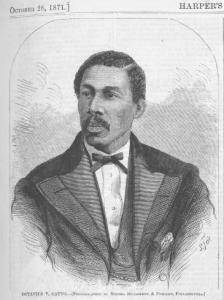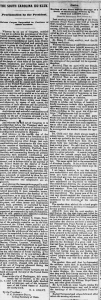150 years ago last month a white man shot and killed a black man in public on Election Day in Philadelphia. In it’s October 28th Harper’s Weekly summarized the murder. In an editorial a week later the paper seemed to blame the Democratic Party.
From the October 28, 1871 issue of Harper’s Weekly:
OCTAVIUS V CATTO.
WE give on this page the portrait of Mr. OCTAVIUS V. CATTO, a worthy colored citizen of Philadelphia, who was shot by a ruffian on the night of the late election in that city. He was master of the Institute for Colored Youth, and was highly esteemed by all who knew him. Shortly after three o’clock on election day, having closed his school, he was quietly proceeding homeward, when he was rudely accosted by a white man, who leveled a pistol at his head. Mr. CATTO endeavored to pass on, taking advantage of the shelter afforded by a passing street-car,but was again accosted by the same ruffian,who then fired at him three times. One ball took effect in his left breast, passing through the heart; another struck him in the left shoulder. He fell immediately. Several citizens carried him into a station-house, where he died a few minutes afterward. Mr. CATTO was a quiet, well-educated man, and the murder was entirely unprovoked.
From the November 4, 1871 issue of Harper’s Weekly:
THE MURDER OF CATTO.
THE murder of Mr. CATTO, a colored teacher in Philadelphia, whose portrait appeared in this paper last week, the meeting of honorable Philadelphians to express sympathy and indignation, and the sneering comments and misrepresentation both of the murder and the meeting which have appeared in the Democratic papers, are striking illustration of what can only be called the essential meanness of that party. Here was a man sprung of a race which had been held in the worst slavery, and whose very color was a badge of social ‘egradation [sic] in a country which professes to honor men simply as men—and a white man knows how hard is the struggle of life when, as in his case, there are no factitious disadvantages; but a man who, like CATTO, quietly braving all the cruel obstructions which contempt, ignorance, prejudice, and hatred throw in his way, devotes himself to the elevation and instruction of his younger brethren in misfortune, and who by his superior intelligence, industry, and stainless character wins the respect and confidence of the best men around him, is worthy of an admiration which is seldom due to a white man under the same circumstances.
Such a man, closing his school in the afternoon upon election day, and quietly walking homeward, is accosted by a white bully, who insults him, levels a pistol, and shoots him on the spot. It would seem as if there could be but one feeling of shame and indignation among all decent men; but the assassin was, of course, a Democrat, his victim was a Republican, and the Democratic papers teem with ribaldry at the fuss made over a dead negro, when scores of white men are murdered without public excitement. It is, we repeat, another illustration of the unspeakable meanness of the Democratic party toward the colored race. That party struggled to hold the race in the most loathsome slavery, and to secure that end it sought the destruction of the government. Baffled in every foul design against them, it can now only encourage the Ku-Klux which harries the colored people in the Southern States, and jeer and insult them even in their bloody graves when murdered by drunken or merely devilish Democrats in the North.
This is the party some of whose Northern leaders affect to acquiesce in the settlement of the war, and which promises to maintain and defend the rights of all citizens more surely than the Republicans! It proved its sincerity by its bitter hostility to emancipation and the civil and political equality bills, by the slaughters at Memphis and New Orleans, by its incessant gibes at the most unfortunate class in the country honorably striving to rise, and now shows it by its sneers over the grave of this honorable and modest citizen of Philadelphia, whose offense in Democratic eyes is that his skin was not white. By their works ye shall know them.


